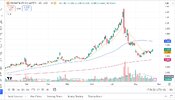Dona Ferentes
Pengurus pengatur
- Joined
- 11 January 2016
- Posts
- 16,472
- Reactions
- 22,475
abort!! abort!! developing a leak ! severe downdraft !

.
Security Code: DRO
Pause in Trading
Trading in the securities of the entity will be temporarily paused pending a further announcement.
.
Security Code: DRO
Pause in Trading
Trading in the securities of the entity will be temporarily paused pending a further announcement.

